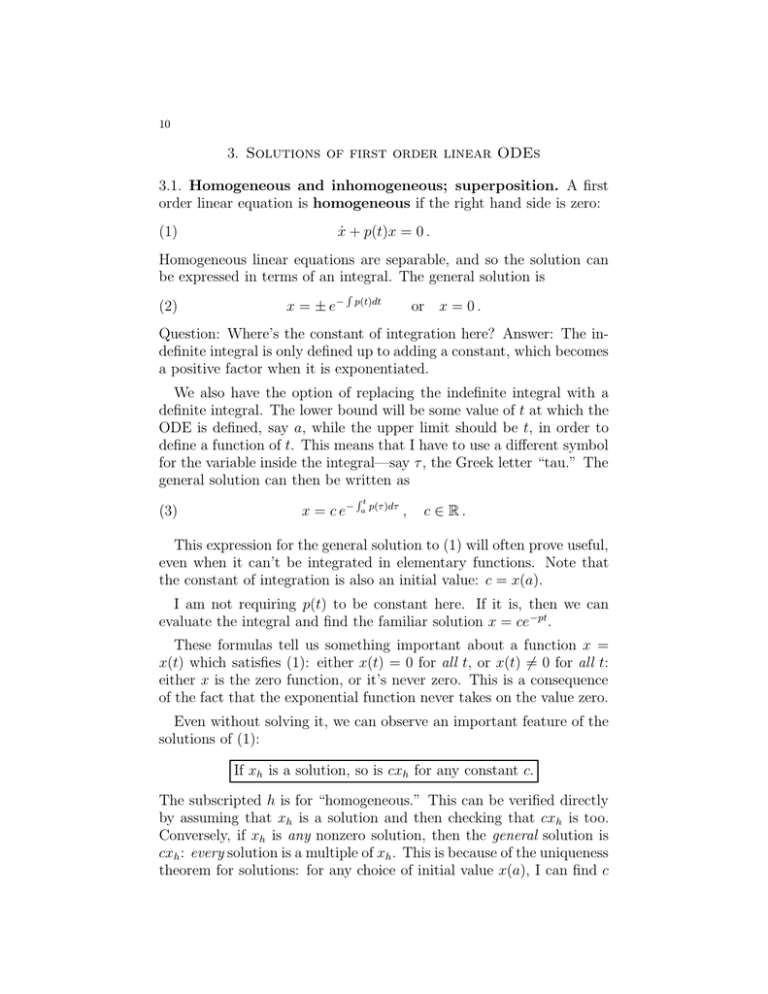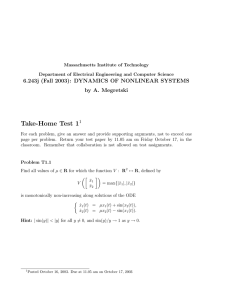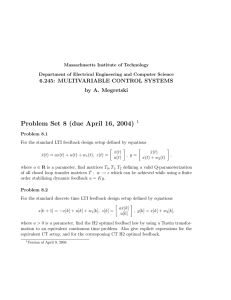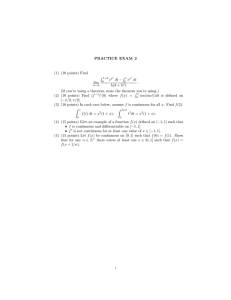3. Solutions of first order ... 3.1. Homogeneous and inhomogeneous; superposition. ...
advertisement

10 3. Solutions of first order linear ODEs 3.1. Homogeneous and inhomogeneous; superposition. A first order linear equation is homogeneous if the right hand side is zero: (1) ẋ + p(t)x = 0 . Homogeneous linear equations are separable, and so the solution can be expressed in terms of an integral. The general solution is (2) x = ± e− R p(t)dt or x = 0 . Question: Where’s the constant of integration here? Answer: The in­ definite integral is only defined up to adding a constant, which becomes a positive factor when it is exponentiated. We also have the option of replacing the indefinite integral with a definite integral. The lower bound will be some value of t at which the ODE is defined, say a, while the upper limit should be t, in order to define a function of t. This means that I have to use a different symbol for the variable inside the integral—say δ , the Greek letter “tau.” The general solution can then be written as (3) x = c e− Rt a p(π )dπ , c ≥ R. This expression for the general solution to (1) will often prove useful, even when it can’t be integrated in elementary functions. Note that the constant of integration is also an initial value: c = x(a). I am not requiring p(t) to be constant here. If it is, then we can evaluate the integral and find the familiar solution x = ce−pt . These formulas tell us something important about a function x = x(t) which satisfies (1): either x(t) = 0 for all t, or x(t) = ∈ 0 for all t: either x is the zero function, or it’s never zero. This is a consequence of the fact that the exponential function never takes on the value zero. Even without solving it, we can observe an important feature of the solutions of (1): If xh is a solution, so is cxh for any constant c. The subscripted h is for “homogeneous.” This can be verified directly by assuming that xh is a solution and then checking that cxh is too. Conversely, if xh is any nonzero solution, then the general solution is cxh : every solution is a multiple of xh . This is because of the uniqueness theorem for solutions: for any choice of initial value x(a), I can find c 11 so that cxh (a) = x(a) (namely, c = x(a)/xh (a)), and so by uniqueness x = cxh for this value of c. Now suppose the input signal is nonzero, so our equation is (4) ẋ + p(t)x = q(t) . Suppose that in one way or another we have found a solution xp to (4). Any single solution will do. We will call it a “particular” solution. Keeping the notation xh for a nonzero solution to the corresponding homogeneous equation (1), we can calculate that xp + cxh is again a solution to (4). Exercise 3.1.1. Verify this. In fact, (5) The general solution to (4) is xp + cxh since any initial condition can be achieved by judicious choice of c. This formula shows how the constant of integration, c, occurs in the general solution of a linear equation. It tends to show up in a more complicated way if the equation is nonlinear. I want to emphasize that despite being called “particular,” the so­ lution xp can be any solution of (4); it need not be special in any way for it to serve in (5). There’s a slight generalization: suppose x1 is a solution to ẋ + p(t)x = q1 (t) and x2 is a solution to ẋ + p(t)x = q2 (t) —same coefficient p(t), so the same system, but two different input signals. Then (for any constants c1 , c2 ) c1 x1 + c2 x2 is a solution to ẋ + p(t)x = c1 q1 (t) + c2 q2 (t) . In our banking example, if we have two bank accounts with the same interest rate, and contribute to them separately, the sum of the ac­ counts will be the same as if we combined them into one account and contributed the sum to the combined account. This is the principle of superposition. The principle of superposition lets us break up the input signal into bitesized pieces, solve the corresponding equations, and add the solu­ tions back together to get a solution to the original equation. 12 3.2. Variation of parameters. Now we try to solve the general first order linear equation, (6) ẋ + p(t)x = q(t) . As we presented it above, the procedure for solving this breaks into two parts. We first find a nonzero solution, say xh , of the associated homogeneous equation (7) ẋ + p(t)x = 0 —that is, (6) with the right hand side replaced by zero. Any nonzero solution will do, and since (7) is separable, finding one is a matter of integration. The general solution to (7) is then cxh for a constant c. The constant c “parametrizes” the solutions to (7). The second step is to somehow find some single solution to (6) itself. We have not addressed this problem yet. One idea is to hope for a solution of the form vxh , where v now is not a constant (which would just give a solution to the homogeneous equation), but rather some function of t, which we will write as v(t) or just v. So let’s make the substitution x = vxh and study the consequences. When we make this substitution in (6) and use the product rule we find vx ˙ h + vẋh + pvxh = q . The second and third terms sum to zero, since xh is a solution to (7), so we are left with a differential equation for v: (8) v̇ = x−1 h q. This can be solved by direct integration once again. Write vp for a particular solution to (8). A particular solution to our original equation (6) is then given by xp = vp xh . By superposition, the general solution is x = xp + cxh . You can also see this by realizing that the general solution to (8) is v = vp + c, so the general solution x is vxh = xp + cxh . Many people like to remember this in the following form: the general solution to (6) is � (9) x = xh x−1 h q dt since the general solution to (8) is v = � 1 x− h q dt. Others just make the substitution x = vxh and do the calculation. 13 Example. The inhomogeneous first order linear ODE we wish to solve is ẋ + tx = (1 + t)et . The associated homogeneous equation is ẋ + tx = 0, 2 which is separable and easily leads to the nonzero solution xh = e−t /2 . So we’ll try for a solution of the original equation of the form x = 2 ve−t /2 . Substituting this into the equation and using the product rule gives us 2 2 2 ve ˙ −t /2 − vte−t /2 + vte−t /2 = (1 + t)et . The second and third terms cancel, as expected, leaving us with v̇ = 2 (1 + t)et+t /2 . Luckily, the derivative of the exponent here occurs as a 2 factor, so this is easy to integrate: vp = et+t /2 (plus a constant, which we might as well take to be zero since we are interested only in finding one solution). Thus a particular solution to the original equation is xp = vp xh = et . It’s easy to check that this is indeed a solution! By 2 (5) the general solution is x = et + ce−t /2 . This method is called “variation of parameter.” The “parameter” is the constant c in the expression cxh for the general solution of the associated homogeneous equation. It is allowed to vary with time in an effort to come up with a solution of the given inhomogeneous equation. The method of variation of parameter is equivalent to the method of integrating factors described in Edwards and Penney; in fact x−1 h is an integrating factor for (6). Either way, we have broken the origi­ nal problem into two problems each of which can be solved by direct integration. 3.3. Continuation of solutions. There is an important theoretical outcome of the method of Variation of Parameters. To see the point, consider first the nonlinear ODE ẋ = x2 . This is separable, with general solution x = 1/(c − t). There is also a “missing solution” x = 0 (which corresponds to c = ↓). As we pointed out in Section 1, the statement that x = 1/(c − t) is a solution is somewhat imprecise. This equation actually defines two solutions: one defined for t < c, and another defined for t > c. These are different solutions. One becomes asymptotic to t = c as t � c; the other becomes asymptotic to t = c as t ∼ c. Neither of these solutions can be extended to a solution defined at t = c; both solutions “blow up” at t = c. This pathological behavior occurs despite the fact that 14 the ODE itself doesn’t exhibit any special pathology at t = c for any value of c. With the exception of the constant solution, no solution can be de­ fined for all time, despite the fact that the equation is perfectly well defined for all time. Another thing that may happen to solutions of nonlinear equations is illustrated by the equation ẋ = −x/y. This is separable, and in implicit form the general solution is x2 + y 2 = c2 , c > 0: circles centered at the origin. To get a function as a solution, one must ≤ restrict to the upper half plane or to the lower half plane: y = ± c2 − x2 . In any case, these solutions can’t be extended to all time, once again, but now for a different reason: they come up to a point at which the tangent line becomes vertical (at x = ±c), and the solution function doesn’t extend past that point. The situation for linear equations is quite different. The fact that continuous functions are integrable (from calculus) shows that if f (t) is defined and continuous on an interval, then all solutions to ẋ = f (t) extend over the same interval. Because the solution to (6) is achieved by two direct integrations, we obtain the following result, which stands in contrast to the situation typical of nonlinear equations. Theorem: If p and q are defined (and reasonably well-behaved) for all t between a and b, then any solution to ẋ + p(t)x = q(t) defined somewhere between a and b extends to a solution defined on the entire interval from a to b. 3.4. Final comments on the bank account model. Let us solve (1) in the special case in which I and q are both constant. In this case the equation ẋ − Ix = q is separable; we do not need to use the method of variation of param­ eters or integrating factors. Separating, dx = I dt x + q/I so integrating and exponentiating, x = −q/I + ceIt , c ≥ R. Let’s look at this formula for a moment. There is a constant solution, namely x = −q/I. I call this the credit card solution. I owe the bank q/I dollars. They “give” me interest, at the rate of I times the 15 value of the bank account. Since that value is negative, what they are doing is charging me: I am using the bank account as a loan, and my “contributions” amount to interest payments on the loan, and exactly balance the interest charges. The bank balance never changes. This steady state solution has large magnitude if my rate of payments is large, or if the interest is small. In calling this the credit card solution, I am assuming that q > 0. If q < 0, then the constant solution x = −q/I is positive. What does this signify? If c < 0, I owe the bank more than can be balanced by my pay­ ments, and my debt increases exponentially. Let’s not dwell on this unfortunate scenario, but pass quickly to the case c > 0, when some of my payments are used to pay off the principal, and ultimately to add to a positive bank balance. That balance then proceeds to grow approximately exponentially. In terms of the initial condition x(0) = x0 , the solution is x = −q/I + (x0 + q/I)eIt . MIT OpenCourseWare http://ocw.mit.edu 18.03 Differential Equations���� Spring 2010 For information about citing these materials or our Terms of Use, visit: http://ocw.mit.edu/terms.



